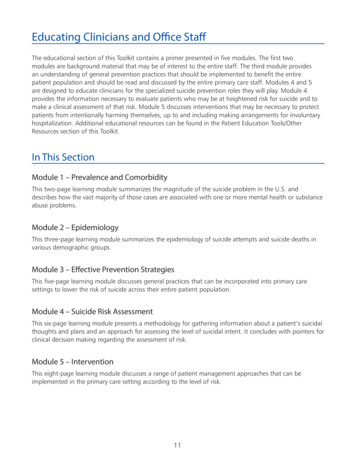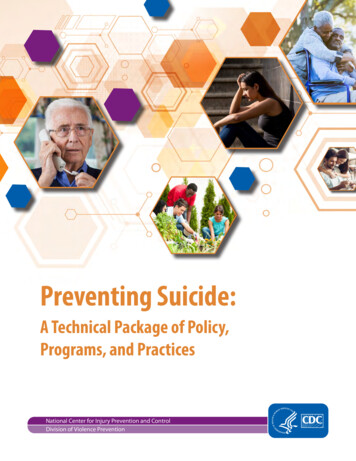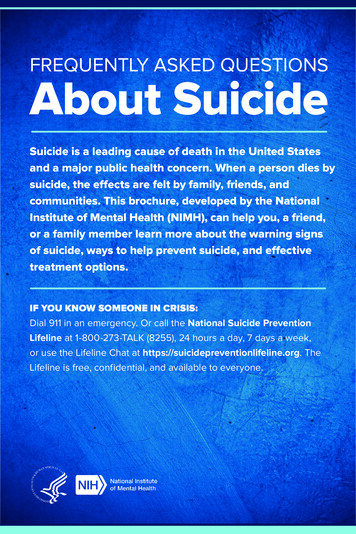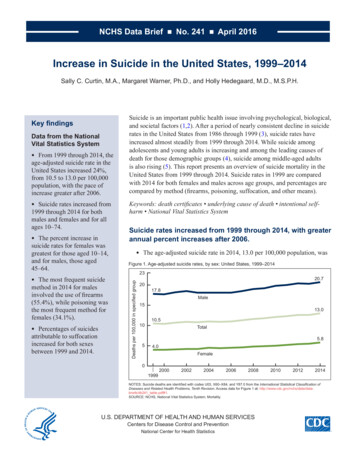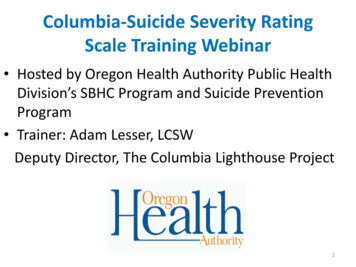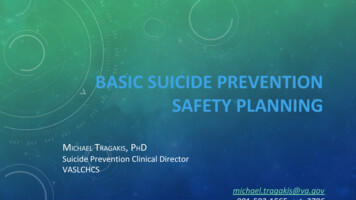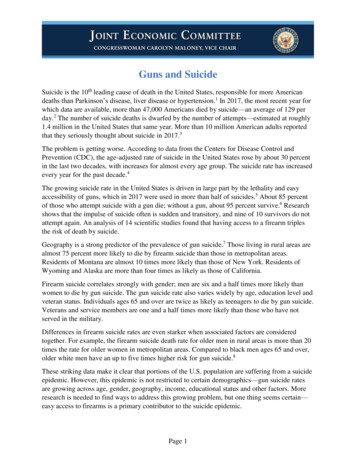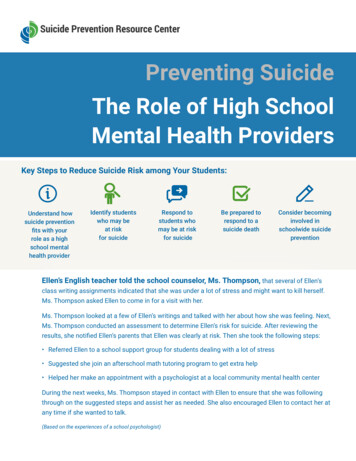
Transcription
Preventing SuicideThe Role of High SchoolMental Health ProvidersKey Steps to Reduce Suicide Risk among Your Students:Understand howsuicide preventionfits with yourrole as a highschool mentalhealth providerIdentify studentswho may beat riskfor suicideRespond tostudents whomay be at riskfor suicideBe prepared torespond to asuicide deathConsider becominginvolved inschoolwide suicidepreventionEllen’s English teacher told the school counselor, Ms. Thompson, that several of Ellen’sclass writing assignments indicated that she was under a lot of stress and might want to kill herself.Ms. Thompson asked Ellen to come in for a visit with her.Ms. Thompson looked at a few of Ellen’s writings and talked with her about how she was feeling. Next,Ms. Thompson conducted an assessment to determine Ellen’s risk for suicide. After reviewing theresults, she notified Ellen’s parents that Ellen was clearly at risk. Then she took the following steps: Referred Ellen to a school support group for students dealing with a lot of stress Suggested she join an afterschool math tutoring program to get extra help Helped her make an appointment with a psychologist at a local community mental health centerDuring the next weeks, Ms. Thompson stayed in contact with Ellen to ensure that she was followingthrough on the suggested steps and assist her as needed. She also encouraged Ellen to contact her atany time if she wanted to talk.(Based on the experiences of a school psychologist)
PREVENTING SUICIDE: THE ROLE OF HIGH SCHOOL MENTAL HEALTH PROVIDERS2Understand How Suicide Prevention Fitswith Your Role as a Mental Health ProviderThis information sheetis for mental health staffwho are responsiblefor handling studentmental health crises,as designated by theschool. For someschools, the mentalhealth contact may needto be a service providerin the community. Allschool staff should knowwho their school’s mainmental health contact is.As a high school mental health provider, you have an important role to play. Youare in a key position to: Observe students’ behavior and act when you suspect that a student may be atrisk for suicide Provide expertise, support, and information to teachers and other staff,students, and parents/legal guardians who may notice that a student isstruggling Determine the next steps to take regarding a student’s safety and treatmentKnow the factsSuicide touches everyone—all ages and incomes; all racial, ethnic, and religious groups; and in allparts of the country. The emotional toll on those left behind remains long after the event. Suicide is thesecond leading cause of death among teenagers in the United States (CDC, 2017). Each year :2,8771 in 61 in 13About 2,877 young peopleages 13 to 19 die by suicide(CDC, 2017).Approximately 1 in 6high school students seriouslyconsider attempting suicide(CDC, 2018).1 in 13 high schoolstudents attempt suicideone or more times(CDC, 2018).However, suicide is preventable.When individuals, schools, and communities join forcesto address suicide, they can save lives.
PREVENTING SUICIDE: THE ROLE OF HIGH SCHOOL MENTAL HEALTH PROVIDERS3Identify Students Who May Be at Risk for SuicideBe alert to factors that can increase suicide riskThere are many factors that may increase a student’s risk for suicide. Some of the mostsignificant ones are: Mental health disorders, e.g., depression,anxiety disorders Substance use disorder Access to a means to kill oneself(i.e., lethal means such as guns ormedications) Previous suicide attempt(s) Family history of suicide Exposure to the suicide of another person Childhood abuse, neglect, or trauma Stressful life circumstances (e.g., schoolproblems, academic and/or disciplinary;family problems; relationship problems orbreakups; bullying; legal problems)Suicide involves the interplay of multiple risk factors. Sometimes stressful lifecircumstances can serve as tipping points and trigger suicidal behavior in adolescents whoare already at increased risk.(Adapted from AFSP, 2018, and AFSP & SPRC, 2018)Crisis LinesBoth of these servicesprovide free, 24/7 supportfor people in suicidalcrisis or emotionaldistress.National SuicidePrevention LifelineCall 1-800-273-TALK(8255)Crisis Text LineText 741741Look for signs of immediate or serious riskLeaders in the suicide prevention field agree that the following warning signs indicate ayoung person may be at risk for suicide:1.Talking about or making plans for suicide2.Expressing hopelessness about the future3.Displaying severe/overwhelming emotional pain or distress4.Showing worrisome behavioral cues or marked changes in behavior, particularly in thepresence of the warning signs above. Specifically, this includes significant: Withdrawal from or change in social connections or situations Changes in sleep (increased or decreased) Anger or hostility that seems out of character or out of context Recent increased agitation or irritabilityRisk is greater in youth who have attempted suicide in the past. Risk is also greater if thewarning sign is new behavior for the student or behavior that has increased and is possiblyrelated to an anticipated or actual painful event, loss, or change.(Expert panel listed at https://www.youthsuicidewarningsigns.org/about, 2013)
PREVENTING SUICIDE: THE ROLE OF HIGH SCHOOL MENTAL HEALTH PROVIDERSAddressCulturalDifferencesDifferences in culturalbackground can affecthow students respond toproblems, the way theytalk about death and dying,and their attitudes towardsuicide, as well as how theyfeel about sharing personalinformation, speaking withadults, and seeking help. Itis important to be aware ofpossible differences andtailor your responses tostudents accordingly. Forexample, individuals fromsome cultures may not beopen to seeing a mentalhealth provider, but theymay be willing to talk witha primary care provider,faith community leader, ortraditional healer.Respond to a Student Who May Be at Risk for SuicideIf you notice any of these signs in a student, take these recommended steps right away:1. Talk with the student. Listen without judging and show you care.2. Assess the student for risk of suicide and other forms of self-injury and/or arrange fora comprehensive risk assessment to be done as soon as possible.3. Take away any potential method of harm, such as a knife or pills.4. Do not leave the student alone (depending on the level of crisis, possibly not even in arestroom).5. Collaborate with a supervisor, any other available behavioral health staff, and theschool administration in making decisions about next steps.6. Notify and involve the parents/legal guardians. They must always be notified whenthere appears to be any risk that a student may harm himself or herself, unless doingso would place the child in a dangerous situation. In the latter case, contact local childprotective services.7. Provide parents with any needed referrals to mental health resources. It is important tobe sensitive to the family’s culture, including attitudes towards suicide, mental health,privacy, and help-seeking.8. Document all actions in order to ensure communication among school staff, parents,and service providers and to make sure the student gets needed services.9. Follow up with the parents to determine how best to provide the student with supportafter the crisis.10. In collaboration with a supervisor, decide what other school personnel should benotified about the student’s elevated risk status (e.g., the student’s teachers, a coach,the school nurse).(Adapted from Los Angeles Unified School District, 2010, and SAMHSA, 2012)For more detailed steps and tools for responding to a student at risk for suicide, seechapter two in Preventing Suicide: A Toolkit for High Schools, which is listed in the“Resources” section of this sheet. For trainings for mental health providers, see Assessingand Managing Suicide Risk and Recognizing and Responding to Suicide Risk: EssentialSkills for Clinicians in the “Resources” section.4
PREVENTING SUICIDE: THE ROLE OF HIGH SCHOOL MENTAL HEALTH PROVIDERSHelp YourColleaguesSuicide can occur amongyour colleagues as wellas among students. If younotice signs of suiciderisk in your colleagues,you can assist them ingetting help too. For moreinformation on how to helpthem, see the “Resources”section, including theinformation sheet The Roleof Co-Workers in PreventingSuicide in the Workplace.5Be Prepared to Respond to a Suicide DeathThe suicide—or violent or unexpected death—of a student, teacher, well-known communitymember, or even a celebrity can increase suicide risk among vulnerable young people.Therefore, an essential part of any crisis or suicide prevention plan is responding appropri ately to a situation that may put students at risk for suicide. This type of response is oftencalled postvention. In a school setting, recommended measures include: Grief counseling for students and staff,and support for yourself Identification of and support for studentswho may be put at risk by a traumaticincident Support for families Communication with the media to reducethe possibility of unsafe news coveragethat could lead to additional suicides oremotional trauma Check-ins with students at risk at latertimes after the death, (e.g., within a monthor on the anniversary of the death)For more information on postvention, see After a Suicide: A Toolkit for Schools, which islisted in the “Resources” section of this sheet.Consider Becoming Involved in Schoolwide SuicidePreventionIdentifying students at risk for suicide is a crucial part of a comprehensive approach tosuicide prevention. As a high school mental health provider, you can also participate in orsupport other aspects of suicide prevention. The following list outlines the key componentsof a comprehensive school suicide prevention program: Schoolwide programs that promoteconnectedness and emotionalwell-being Identifying students at risk andin crisis and connecting themwith help Postvention Parent/guardian education and outreach Student programs (e.g., curricula for allstudents, skill-building for students at risk,peer leader programs) Screening students at risk Policies and procedures for implementingthe components above Staff education and trainingFor more information about comprehensive school suicide prevention programs, seePreventing Suicide: A Toolkit for High Schools in the “Resources” section.
PREVENTING SUICIDE: THE ROLE OF HIGH SCHOOL MENTAL HEALTH PROVIDERSResourcesAfter a Suicide: A Toolkit for Schools, Second EditionBy the American Foundation for Suicide Prevention and theSuicide Prevention Resource Center (2018)http://www.sprc.org/library resources/items/after-suicidetoolkit-schoolsThis online resource provides basic information andpractical tools for schools to use in developing andimplementing a coordinated response to the suicide deathof a student. It includes sections on crisis response teamsand activities; helping students cope; addressing issuesrelated to memorials, social media, and contagion; andworking with the media and the community.Preventing Suicide: A Toolkit for High SchoolsBy the Substance Abuse and Mental Health ServicesAdministration uicide-AToolkit-for-High-Schools/SMA12-4669?WTThis toolkit helps high schools, school districts, and theirpartners design and implement strategies to preventsuicide and promote behavioral health among theirstudents. It describes the steps necessary to implement allthe components of a comprehensive school-based suicideprevention program and contains numerous tools to helpcarry out the steps.Assessing and Managing Suicide Risk: Core Competenciesfor Behavioral Health Professionals (AMSR)By the Suicide Prevention Resource Center and theAmerican Association of Suicidology(Revised April is is a one-day curriculum for mental healthprofessionals. It combines lecture, video demonstrations,and exercises to learn to effectively assess suicide risk,plan treatment, and manage ongoing care of clients atrisk. Trainings are sponsored by community groups andfacilitated by AMSR’s nationwide roster of expert faculty.Preventing Suicide: The Role of High School TeachersBy the Suicide Prevention Resource Center (revised zed-informationpageThis information sheet helps high school teachersrecognize and respond to the warning signs and riskfactors for suicide in their students.Finding Programs and PracticesBy the Suicide Prevention Resource Center ng-programspracticesThis webpage provides information on SPRC’s “Resourcesand Programs” webpage and other program registries andlists, as well as suggestions for selecting programs.Los Angeles County Youth Suicide Prevention Projecthttp://preventsuicide.lacoe.edu/This project’s website has separate sections for schooladministrators, school staff, parents, and students. Eachsection contains information sheets, videos, and otherhelpful resources. The website also has links to resourceson a variety of populations at risk and special issues insuicide prevention.Recognizing & Responding to Suicide Risk: Essential Skillsfor Clinicians (RRSR)By the American Association of Suicidology ation/rrsrThis is an advanced two-day interactive training for mentalhealth clinicians. It covers the knowledge, skills, andattitudes required to effectively assess, manage, and treatindividuals at risk for suicide. Instruction consists of aninitial web-based assessment, followed by a two-day, faceto-face classroom workshop, and an online post-workshopmentorship. Training is delivered by RRSR master trainersbased throughout the United States.Society for the Prevention of Teen Suicide (SPTS)http://www.sptsusa.orgSPTS develops educational materials and trainingprograms for teens, parents, and educators, and itswebsite contains separate sections for each group.SPTS is the developer of the online course MakingEducators Partners in Youth Suicide Prevention and theLifelines Trilogy manuals and workshops covering suicideprevention, intervention, and postvention for educators andschool staff.6
PREVENTING SUICIDE: THE ROLE OF HIGH SCHOOL MENTAL HEALTH PROVIDERSSuicide Prevention among LGBT Youth: A Workshop forProfessionals Who Serve YouthBy the Suicide Prevention Resource Center youth-workshopThis kit provides all the materials needed to hosta workshop to help staff in schools, youth-servingorganizations, and suicide prevention programs take actionto reduce suicidal behavior among lesbian, gay, bisexual,and transgender (LGBT) youth. It includes a leader’s guide,sample agenda, PowerPoint, sample script, handouts, andsmall group exercises.Suicide Warning Signs (wallet card)By the National Suicide Prevention Lifeline esources/This wallet-sized card contains the warning signs forsuicide and the toll-free number of the National SuicidePrevention Lifeline.The Role of Co-Workers in Preventing Suicide in theWorkplaceBy the Suicide Prevention Resource Center (revised ation-seriesThis information sheet helps people in any type ofworkplace learn how to recognize and respond to thewarning signs for suicide in their co-workers.The Trevor Projecthttp://www.thetrevorproject.orgThe Trevor Project is a national organization with a focuson crisis and suicide prevention among lesbian, gay,bisexual, transgender, and questioning (LGBTQ) youth. Itprovides counseling by phone, text, and chat; an onlinesocial networking community for LGBTQ youth and theirfriends and allies; educational programs for schools; andadvocacy initiatives.Youth Suicide Prevention, Intervention, and PostventionGuidelines: A Resource for School PersonnelBy the Maine Youth Suicide Prevention Program (2009, lines%20102009--w%20discl.pdfThis guide describes the components of a comprehensiveschool-based suicide prevention program. It also includesan assessment form to help schools determine if they areready to manage suicidal behavior; detailed guidelinesfor implementing suicide intervention and postvention inschools; and appendices with related materials, includingforms and handouts.Youth Suicide Prevention School-Based GuideBy the Louis de la Parte Florida Mental Health Institute,University of South Florida (2012 Update)http://theguide.fmhi.usf.edu/This guide provides a framework for schools to assesstheir existing or proposed suicide prevention efforts andresources, and information that school administratorscan use to enhance or add to their existing programs.Topics include administrative issues, risk and protectivefactors, prevention guidelines, intervention and postventionstrategies, and school climate.In addition to these resources, SPRC’s webpage on schoolshas many other useful materials. Go to http://www.sprc.org/settings/schools7
PREVENTING SUICIDE: THE ROLE OF HIGH SCHOOL MENTAL HEALTH PROVIDERS8ReferencesAmerican Foundation for Suicide Prevention (AFSP). (2018). Risk factors and warning signs. Retrieved from rning-signs/American Foundation for Suicide Prevention, & Suicide Prevention Resource Center. (2018). After a suicide: A toolkitfor schools (2nd ed.). Waltham, MA: Education Development Center, Inc. http://www.sprc.org/library rs for Disease Control and Prevention (CDC). (2017). Web-based injury statistics query and reporting system(WISQARS): Fatal injury data, national and regional, 1999–2017. Retrieved from Centers for Disease Control and Prevention (CDC). (2018). Youth risk behavior surveillance – United States, 2017.Surveillance Summaries. MMWR, 67(8). Retrieved from 7/ss6708.pdfLos Angeles Unified School District, Student Health and Human Services. (n.d.). Suicide Prevention Awareness forStaff. Retrieved from arenes Staff.pdfSubstance Abuse and Mental Health Services Administration (SAMHSA). (2012). Preventing suicide: A toolkit forhigh schools. Rockville, MD: Center for Mental Health Services, Substance Abuse and Mental Health ServicesAdministration. Retrieved from -A-Toolkit-for-High-Schools/SMA12-4669?WTYouth suicide warning signs. (2013). Retrieved from eprofessionalsRevised May 2019This publication may be copied, reproduced, and distributed provided the copyright notice, author credit, and SPRC’swebsite address (sprc.org) are included. For additional rights, such as adapting or excerpting a portion of thematerial for publication, please submit a request via our Contact Us form.Suicide Prevention Resource CenterWeb: http://www.sprc.orgEducation Development Center (EDC) is a global nonprofit that advanceslasting solutions to improve education, promote health, and expand economicopportunity. Since 1958, we have been a leader in designing, implementing,and evaluating powerful and innovative programs in more than 80 countriesaround the world. Visit edc.orgThe Suicide Prevention Resource Center at EDC is supported by a grant from the U.S.Department of Health and Human Services (HHS), Substance Abuse and Mental HealthServices Administration (SAMHSA), Center for Mental Health Services (CMHS), underGrant No. 5U79SM062297. The views, opinions, and content expressed in this productdo not necessarily reflect the views, opinions, or policies of CMHS, SAMHSA, or HHS.
high school students seriously consider attempting suicide (CDC, 2018). 1 in 13 high school students attempt suicide one or more times (CDC, 2018). Understand How Suicide Prevention Fits with Your Role as a Mental Health Provider As a high school mental health provider, you have an important role to play. You are in a key position to:


